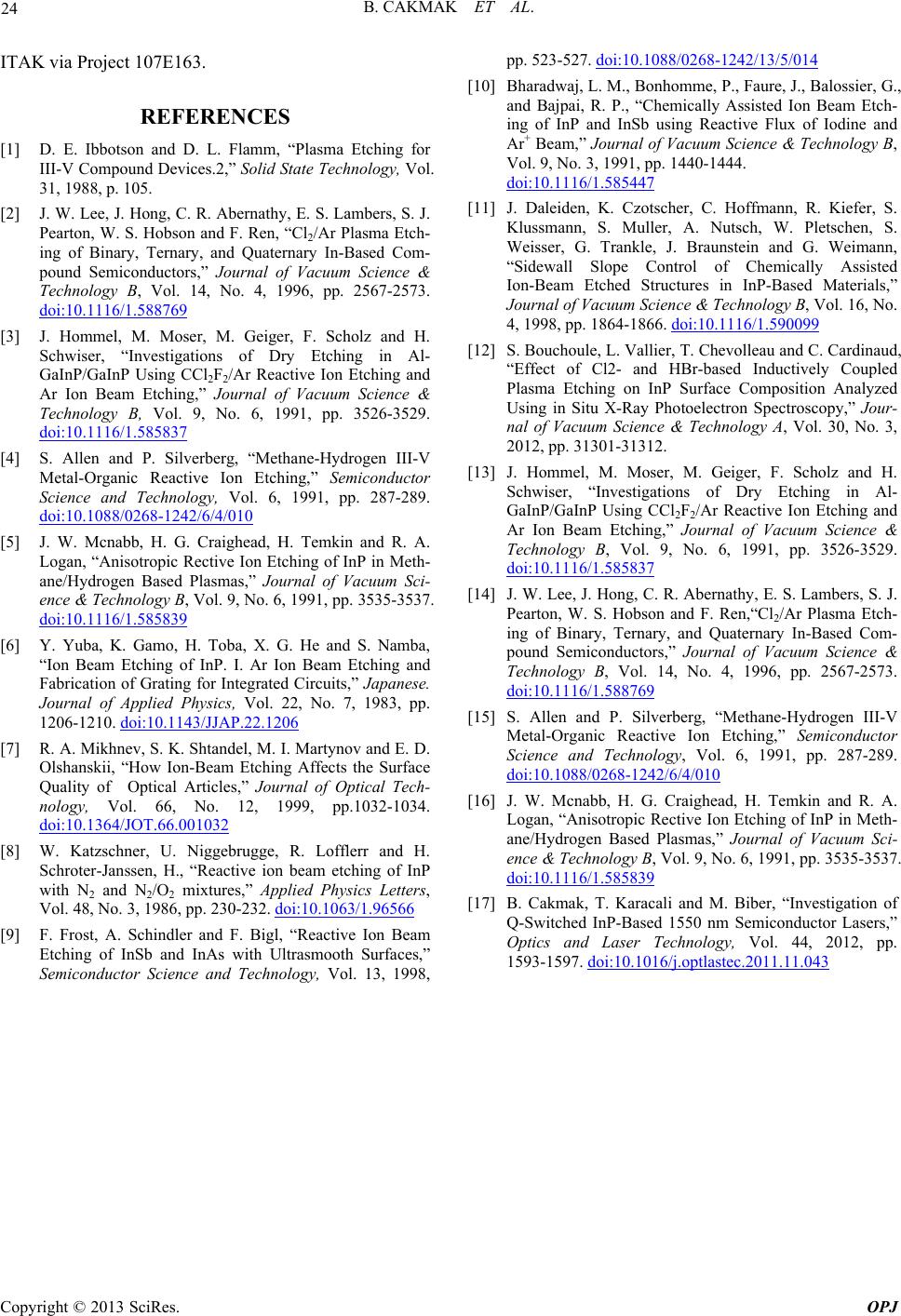
B. CAKMAK ET AL.
Copyright © 2013 SciRes. OPJ
24
ITAK via Project 107E163.
REFERENCES
[1] D. E. Ibbotson and D. L. Flamm, “Plasma Etching for
III-V Compound Devices.2,” Solid State Technology, Vol.
31, 1988, p. 105.
[2] J. W. Lee, J. Hong, C. R. Abernathy, E. S. Lambers, S. J.
Pearton, W. S. Hobson and F. Ren, “Cl2/Ar Plasma Etch-
ing of Binary, Ternary, and Quaternary In-Based Com-
pound Semiconductors,” Journal of Vacuum Science &
Technology B, Vol. 14, No. 4, 1996, pp. 2567-2573.
doi:10.1116/1.588769
[3] J. Hommel, M. Moser, M. Geiger, F. Scholz and H.
Schwiser, “Investigations of Dry Etching in Al-
GaInP/GaInP Using CCl2F2/Ar Reactive Ion Etching and
Ar Ion Beam Etching,” Journal of Vacuum Science &
Technology B, Vol. 9, No. 6, 1991, pp. 3526-3529.
doi:10.1116/1.585837
[4] S. Allen and P. Silverberg, “Methane-Hydrogen III-V
Metal-Organic Reactive Ion Etching,” Semiconductor
Science and Technology, Vol. 6, 1991, pp. 287-289.
doi:10.1088/0268-1242/6/4/010
[5] J. W. Mcnabb, H. G. Craighead, H. Temkin and R. A.
Logan, “Anisotropic Rective Ion Etching of InP in Meth-
ane/Hydrogen Based Plasmas,” Journal of Vacuum Sci-
ence & Technology B, Vol. 9, No. 6, 1991, pp. 3535-3537.
doi:10.1116/1.585839
[6] Y. Yuba, K. Gamo, H. Toba, X. G. He and S. Namba,
“Ion Beam Etching of InP. I. Ar Ion Beam Etching and
Fabrication of Grating for Integrated Circuits,” Japanese.
Journal of Applied Physics, Vol. 22, No. 7, 1983, pp.
1206-1210. doi:10.1143/JJAP.22.1206
[7] R. A. Mikhnev, S. K. Shtandel, M. I. Martynov and E. D.
Olshanskii, “How Ion-Beam Etching Affects the Surface
Quality of Optical Articles,” Journal of Optical Tech-
nology, Vol. 66, No. 12, 1999, pp.1032-1034.
doi:10.1364/JOT.66.001032
[8] W. Katzschner, U. Niggebrugge, R. Lofflerr and H.
Schroter-Janssen, H., “Reactive ion beam etching of InP
with N2 and N2/O2 mixtures,” Applied Physics Letters,
Vol. 48, No. 3, 1986, pp. 230-232. doi:10.1063/1.96566
[9] F. Frost, A. Schindler and F. Bigl, “Reactive Ion Beam
Etching of InSb and InAs with Ultrasmooth Surfaces,”
Semiconductor Science and Technology, Vol. 13, 1998,
pp. 523-527. doi:10.1088/0268-1242/13/5/014
[10] Bharadwaj, L. M., Bonhomme, P., Faure, J., Balossier, G.,
and Bajpai, R. P., “Chemically Assisted Ion Beam Etch-
ing of InP and InSb using Reactive Flux of Iodine and
Ar+ Beam,” Journal of Vacuum Science & Technology B,
Vol. 9, No. 3, 1991, pp. 1440-1444.
doi:10.1116/1.585447
[11] J. Daleiden, K. Czotscher, C. Hoffmann, R. Kiefer, S.
Klussmann, S. Muller, A. Nutsch, W. Pletschen, S.
Weisser, G. Trankle, J. Braunstein and G. Weimann,
“Sidewall Slope Control of Chemically Assisted
Ion-Beam Etched Structures in InP-Based Materials,”
Journal of Vacuum Science & Technology B, Vol. 16, No.
4, 1998, pp. 1864-1866. doi:10.1116/1.590099
[12] S. Bouchoule, L. Vallier, T. Chevolleau and C. Cardinaud,
“Effect of Cl2- and HBr-based Inductively Coupled
Plasma Etching on InP Surface Composition Analyzed
Using in Situ X-Ray Photoelectron Spectroscopy,” Jour-
nal of Vacuum Science & Technology A, Vol. 30, No. 3,
2012, pp. 31301-31312.
[13] J. Hommel, M. Moser, M. Geiger, F. Scholz and H.
Schwiser, “Investigations of Dry Etching in Al-
GaInP/GaInP Using CCl2F2/Ar Reactive Ion Etching and
Ar Ion Beam Etching,” Journal of Vacuum Science &
Technology B, Vol. 9, No. 6, 1991, pp. 3526-3529.
doi:10.1116/1.585837
[14] J. W. Lee, J. Hong, C. R. Abernathy, E. S. Lambers, S. J.
Pearton, W. S. Hobson and F. Ren,“Cl2/Ar Plasma Etch-
ing of Binary, Ternary, and Quaternary In-Based Com-
pound Semiconductors,” Journal of Vacuum Science &
Technology B, Vol. 14, No. 4, 1996, pp. 2567-2573.
doi:10.1116/1.588769
[15] S. Allen and P. Silverberg, “Methane-Hydrogen III-V
Metal-Organic Reactive Ion Etching,” Semiconductor
Science and Technology, Vol. 6, 1991, pp. 287-289.
doi:10.1088/0268-1242/6/4/010
[16] J. W. Mcnabb, H. G. Craighead, H. Temkin and R. A.
Logan, “Anisotropic Rective Ion Etching of InP in Meth-
ane/Hydrogen Based Plasmas,” Journal of Vacuum Sci-
ence & Technology B, Vol. 9, No. 6, 1991, pp. 3535-3537.
doi:10.1116/1.585839
[17] B. Cakmak, T. Karacali and M. Biber, “Investigation of
Q-Switched InP-Based 1550 nm Semiconductor Lasers,”
Optics and Laser Technology, Vol. 44, 2012, pp.
1593-1597. doi:10.1016/j.optlastec.2011.11.043